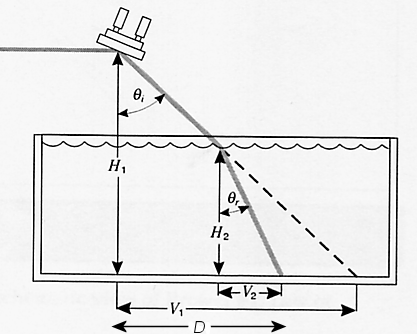

Objective:
In this laboratory students will become familiar with the equipment in the Newport "Projects in Optics" kit. They will use components from the kit to verify the laws of reflection and refraction.
| Reflection is the abrupt change in the direction of propagation of a wave that strikes the boundary between two different media. At least some part of the incoming wave remains in the same medium. If an incoming light ray makes an angle θi with the normal of a plane tangent to the boundary, then the reflected ray makes an angle θr with this normal and lies in the same plane as the incident ray and the normal. |
Law of reflection: |θr| =|θi|
| Refraction is the change in direction of propagation of a wave when the wave passes from one medium into another, and changes its speed. The speed of light in a given substance is v = c/n, where n is the index of refraction of the substance. Light waves are refracted when crossing the boundary from one transparent medium into another because the speed of light is different in different media. |
Snell's law, or the law of refraction: nisinθi = ntsinθt.
![]()
| Laser Assembly | |
| Beam Steering Assemblies | |
| Rotation Stage | |
| Clear Plastic Tank | |
| Meter Stick | |
| Project in Optics Workbook |
![]()
Students will follow the instructions on pages 45 - 48 of the Projects in Optics Workbook. To assemble the components, they will refer to pages 36 - 44 in the Projects in Optics Workbook.
| Part 1: The law of reflection Set your component case next to the optical breadboard, as shown in the picture below. Open the lid of the case, and observe the reflected beam on the lid instead of on the wall. |

First reflect the laser beam from the middle of a mirror approximately 50 cm away from the output hole back onto the laser output hole. Use a mirror with a center-of-rotation adaptor so you later can turn it easily, and use a collar to fix the height of the mirror, so the height does not change when you loosen the screw in the post holder to turn the mirror.
Use lens paper in the beam path to observe the incident as well as the reflected beam and adjust the mirror so that the reflected beam overlaps the incident beam.
Measure X, Y, and the initial angle θ0 and final position of the rotation stage θ for at least three different final positions of the rotation stage. If the law of reflection holds then Δθ = θ - θ0 = θr/2. Check if you verified the law of reflection by calculating the percentage difference |(2Δθ - θr)/(2Δθ)|.
| Part 2: The law of refraction Keep the first mirror mounted onto the rotation stage, and deflect the beam by 90 degrees. Intercept the beam with the second mirror and deflect it again by 90 degrees. Keep the beam level above the breadboard. Your experimental setup should look like the one shown in the picture below. |

Measure H1, H2, V1, V2, and calculate θi and θr. Compare your measured index of refraction of water with the expected index of refraction of 1.33. If you have trouble measuring V2, measure D, and use H1/V1 = H2/(V1 - D + V2), V2 = (H2/H1 - 1)V1 + D, or, in some other way, make use of the properties of similar triangles.

![]()
Part 1:
Construct an Excel spreadsheet:
| θ0 (rotation stage) |
θ (rotation Stage) |
Δθ
= θ - θ0 |
Y | X | θr=tan-1(Y/X) | |(2Δθ - θr)/(2Δθ)| |
What is the percentage difference between your experimental and the expected result?
Part 2:
Construct an Excel spreadsheet:
| H1 | V1 | H2 | V2 | θi | θr | nexp | |(n-nexp)/n| |
What is the percentage difference between your experimental result nexp and the expected result n = 1.33?
![]()
Open Microsoft Word and prepare a report using the template shown below.
Name:E-mail address:
Laboratory 1 report:
| In a few words, describe the experiment. (What?) | |
| In a few words, state the objective of the experiment. (Why?) | |
| Comment on the procedure. Did you encounter difficulties or surprises? (How?) | |
| Present your results and comment on your results. |